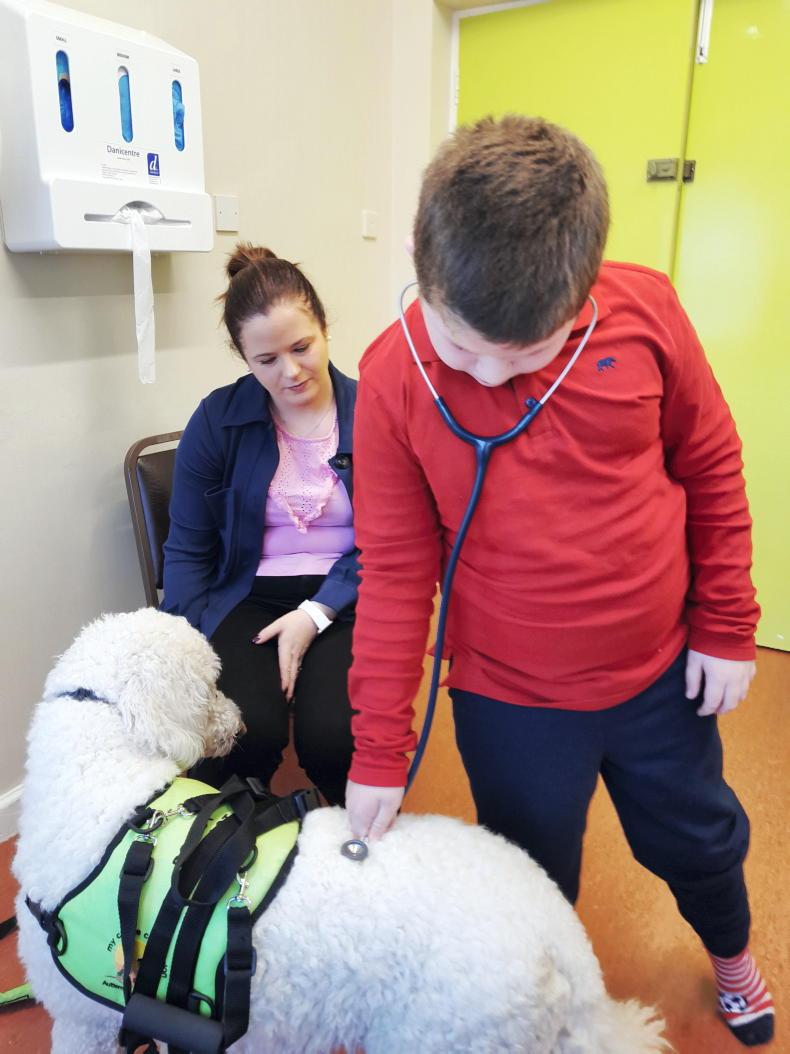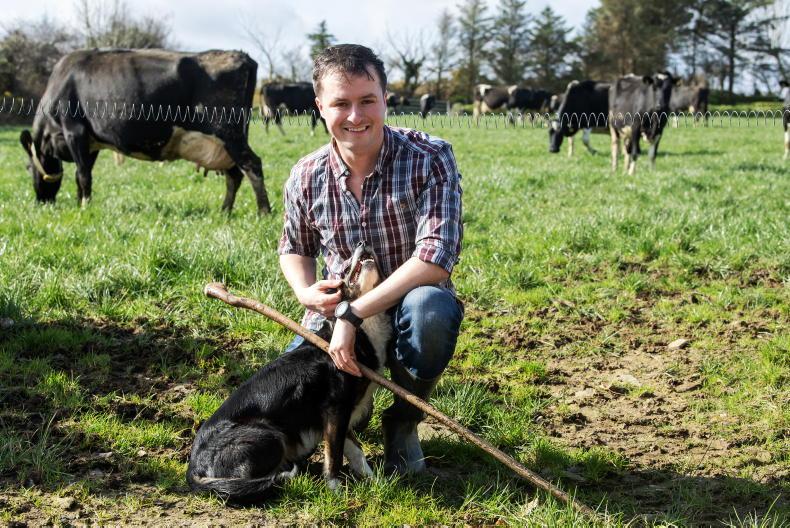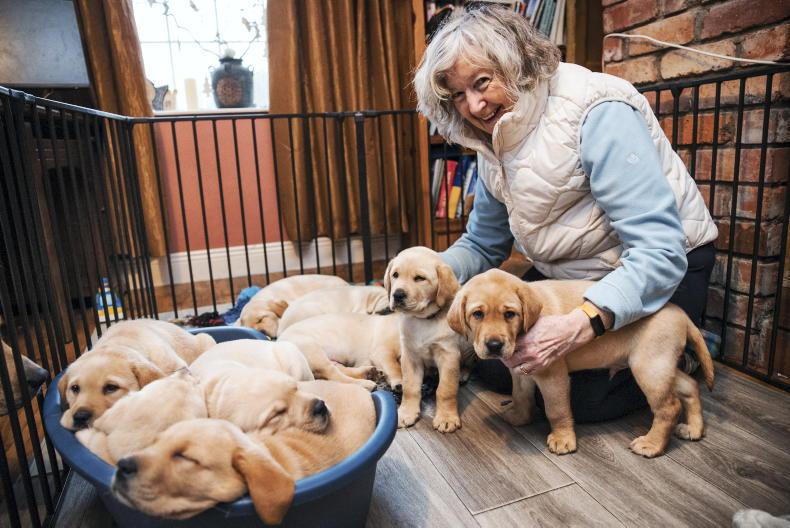We wouldn’t be without her.”
That’s John Mulvihill’s comment about Sue, the autism service dog that his nine-year-old son Seamus has had since March this year.
Sue is a Sheppadoodle cross and like a big teddy bear, John says. Sue was provided to the Mulvihill family from My Canine Companion, a Cork based charity that supports families with children with autism.
“Kids with autism have sensory needs and Seamus would often bury his two hands in Sue’s curly fur. It seems to calm him down. These small things are a bonus.”
John is a civil engineer with Leitrim County Council as well as a part-time organic sheep and suckler farmer.
Seamus is what’s known as a flight risk and if a situation overwhelms him, he may run off.
“Occasionally Seamus may have little concept of danger,” his dad says. “The difference in danger between a puddle and a lake are often unclear to Seamus. He would consider the risk of getting wet before realising how deep the water may be. Being attached to Sue means he can’t bolt as he is strapped to the dog via a lanyard at his waist.”
Seamus’s parents tell him that Sue is his helper dog and that when they go out, he must mind her.
“It’s reverse psychology. It has worked brilliantly for us in towns and busy places. Of course, Sue is under your command, as parent or handler, but Seamus gets the sense that he is minding the dog so it’s a distraction for him. Also, in his own head, he feels that he is free to walk like his sibling Padraig, seven, although he is attached to the dog. If he does decide to wander away from us, he is held up by the attachment to Sue. Now if we see him getting uneasy, for example in a crowded or noisy environment, we can say, ‘Sue doesn’t like it here, we’d better go’ and we do. In the past it wasn’t so simple. We’ve had situations where Seamus couldn’t cope and very often it would end in tears and when he was younger, we would carry him back to the car.”
A conversation starter
Having a dog like Sue has also helped with socialisation for Seamus because the dog is a conversation starter when the family are out.
“Some people are shy or afraid of approaching a child with autism in case they’d annoy them, or often times people may simply struggle to initiate a conservation,” John says, “but when a dog is there you can say ‘oh, you’ve a lovely dog’ or ‘what’s your dog’s name?’ and you’ll either get a reaction then or you won’t, but you know then, without causing any trouble, whether that child is going to talk to you or not. People speaking to Seamus like that when we’re out is brilliant because it teaches him the skill of speaking to others on middle ground. It gets him talking with the world, not just his family.”
Let’s try it
The Mulvihills got the idea of getting an assistance dog for Seamus after seeing My Canine Companion (MCC) charity directors Cliona and Niall Ruddy talking about the service one night on the Late Late Show.
“I said to my wife, Grace, ‘if it’s any help let’s try it’,” John says.
When their eldest child hadn’t met his 18 month developmental milestones, John and Grace had been worried.
“We knew his speech was way behind, it was very hard to get him to sleep and we noticed that he was lining up his toys in an unusual way. It crossed my mind at that time that he had autism, but he was four before we got the diagnosis,” John says.
He admits that they were in denial for a while, however.
“You never think it will happen to you. All parents are in denial about their kids, I’ve noticed that. Everyone loves their kids to bits. It’s the same with any child that has an additional need like autism, Down’s syndrome, ADHD, or whatever. You tend to bury your head in the sand hoping it will go away. It’s very hard when it’s your child, but early intervention is the best thing you could do for him or her.”
Fundraising
The Mulvihills embarked on a major fundraising campaign after contacting MCC, as each dog costs the charity about €10,000 to train and support a family over its lifetime.
“I said to Niall ‘if you can help us, we’ll help you’. Fundraising was nothing new to us as my brother died of leukaemia in 1999 and my parents, along with a number of close family friends, had been fundraising for St James’s ever since, raising over €150,000. So in 2018, we set about fundraising for a different charity. Instead of raising for St. James’s, we decided to raise money for My Canine Companion in the hope we would avail of their services. Our families and friends in Glenfarne raised over €20,000 locally with a Christmas fair and a big family walk on St Stephen’s Day. People who couldn’t attend donated via a Go-fund me page. The support was heartfelt. I suppose that’s the wonderful thing about rural areas like Glenfarne - people really rally round you. They were all invested in the charity as they were going to help Seamus out as a neighbour’s child.”
First dog- Fiachra
Seamus got his first service dog very soon after that – Fiachra – a German Shepherd/poodle cross, which ultimately didn’t work out, however.
“We did all the training, meeting up with other dog owners and so on, but then we had lockdown and we couldn’t go anywhere. We had problems when lockdown ended because whenever Fiachra saw another dog, he would bark. It seemed like every John and Mary had a dog after lockdown – they were everywhere we went. Fiachra couldn’t help himself. He would bark at random dogs on the street, and as a result we had to correct him, but Seamus hates anyone being given out to. It was very stressful for Seamus because he didn’t understand why Fiachra was now ‘such a loud doggy’.  It was a double whammy for us trying to correct the dog and keep Seamus happy. We never envisaged that we’d need a second dog, but in the end the charity’s trainers decided that Fiachra was to be taken out of service. We then kept him as a family pet as he was best buddies with our working sheepdog, Bess, and Padraig, our other son, and now we have Sue who is working out great for Seamus.”
It was a double whammy for us trying to correct the dog and keep Seamus happy. We never envisaged that we’d need a second dog, but in the end the charity’s trainers decided that Fiachra was to be taken out of service. We then kept him as a family pet as he was best buddies with our working sheepdog, Bess, and Padraig, our other son, and now we have Sue who is working out great for Seamus.”
Puts normality into Sundays and fundays
Sue allows the family to do things they weren’t able to do before like enjoy Sundays (what they call their Fundays) out and about. “With working full-time, Monday to Friday and farming in the evenings and on Saturdays, Sundays are our family days,” John says.
Routine is regimental for anyone with autism, so the Mulvihills do the same thing each time.
“We go to the car park in Sligo, into the shopping centre, upstairs to a shop where there are small car toys and to a second hand DVD shop, then to Eason’s where we read a couple of books together. We might buy a CD also – he is fascinated with country music [thanks to his mammy] then we head to the car and somewhere to do the grocery shopping for the week. Depending on the humour, Seamus might want to listen to the music in the car or we might all go in, Sue and all, with Seamus attached.”
Lessens stress
There are other situations when Sue is more than helpful too.
“Going to the doctors is also not such an ordeal now as the dog is a conversation opener for the doctors and a big distraction for Seamus. Having Sue brings some normality, but there are things we want to do still. We’ll get there in time. We bring her lots of places – to shops, play days, she’ll lie down in the play centre while Seamus plays with Padraig. Having her certainly opens doors to things we couldn’t do before.”
When it comes to sensory needs, as well as getting comfort from stroking Sue’s coat, Seamus needs regular movement breaks and exercise.
“I’d often spend half an hour with Seamus before or after school jumping on the trampoline. It helps him to get all the stuff out of his head.”
Facing up
In relation to accepting that your child has difficulty, the couple look back on their experience of this.
“Sometimes you have to face your enemies, take the bull by the horns. That was how we reached out to My Canine Companions. We were desperate to get help in any form.”
John had been writing repeatedly to the HSE for speech therapy and occupational therapy for Seamus.
“Sadly, services for children with special needs are so behind in this country,” he says. “The only way I could get traction was by writing letters. Phone calls were no good. Of course, having an assistance dog is no magic wand. It doesn’t take away autism by any means, but Sue makes a big difference. When you have a child like Seamus, no matter how small the help may be, you’ll go after it for your child. That’s just the way it is.” CL
My Canine Companion is accredited by Assistance Dog International (ADI). Training includes up to 18 months on the Puppy Socialisation Scheme/puppy programme, followed by four months intensive training with instructors.
Main purposes of My Canine Companion dog
The safety aspect – vital for both child and family. The dog acts as an anchor when tethered to the child, thereby alleviating bolting behaviours. The best friend/companion/playmate aspect for children that almost always have few friends outside the immediate family circle.
How it works
The dog wears a specially designed jacket with logo.The child is attached to the dog.The parent has a lead that is attached to the dog.The child holds a handle that is on the dog’s jacket. The dog is trained to walk ahead with the child yet respond to verbal commands given by the parent e.g. the dog will stop at any obstacle in its path.How much does a service dog cost?
The cost to the charity of providing their fully qualified service dogs over a two-year programme and continuing lifetime support is €10,000.My Canine Companion does not charge any of their clients for the provision of their service dog programmes. My Canine Companion doesn’t receive any government funding so it relies solely on fundraising.More info
MCC is based in Cork and the website is www.mycaninecompanion.ie
Read more
Health: cutting back on the booze
Closure crisis in nursing home sector
We wouldn’t be without her.”
That’s John Mulvihill’s comment about Sue, the autism service dog that his nine-year-old son Seamus has had since March this year.
Sue is a Sheppadoodle cross and like a big teddy bear, John says. Sue was provided to the Mulvihill family from My Canine Companion, a Cork based charity that supports families with children with autism.
“Kids with autism have sensory needs and Seamus would often bury his two hands in Sue’s curly fur. It seems to calm him down. These small things are a bonus.”
John is a civil engineer with Leitrim County Council as well as a part-time organic sheep and suckler farmer.
Seamus is what’s known as a flight risk and if a situation overwhelms him, he may run off.
“Occasionally Seamus may have little concept of danger,” his dad says. “The difference in danger between a puddle and a lake are often unclear to Seamus. He would consider the risk of getting wet before realising how deep the water may be. Being attached to Sue means he can’t bolt as he is strapped to the dog via a lanyard at his waist.”
Seamus’s parents tell him that Sue is his helper dog and that when they go out, he must mind her.
“It’s reverse psychology. It has worked brilliantly for us in towns and busy places. Of course, Sue is under your command, as parent or handler, but Seamus gets the sense that he is minding the dog so it’s a distraction for him. Also, in his own head, he feels that he is free to walk like his sibling Padraig, seven, although he is attached to the dog. If he does decide to wander away from us, he is held up by the attachment to Sue. Now if we see him getting uneasy, for example in a crowded or noisy environment, we can say, ‘Sue doesn’t like it here, we’d better go’ and we do. In the past it wasn’t so simple. We’ve had situations where Seamus couldn’t cope and very often it would end in tears and when he was younger, we would carry him back to the car.”
A conversation starter
Having a dog like Sue has also helped with socialisation for Seamus because the dog is a conversation starter when the family are out.
“Some people are shy or afraid of approaching a child with autism in case they’d annoy them, or often times people may simply struggle to initiate a conservation,” John says, “but when a dog is there you can say ‘oh, you’ve a lovely dog’ or ‘what’s your dog’s name?’ and you’ll either get a reaction then or you won’t, but you know then, without causing any trouble, whether that child is going to talk to you or not. People speaking to Seamus like that when we’re out is brilliant because it teaches him the skill of speaking to others on middle ground. It gets him talking with the world, not just his family.”
Let’s try it
The Mulvihills got the idea of getting an assistance dog for Seamus after seeing My Canine Companion (MCC) charity directors Cliona and Niall Ruddy talking about the service one night on the Late Late Show.
“I said to my wife, Grace, ‘if it’s any help let’s try it’,” John says.
When their eldest child hadn’t met his 18 month developmental milestones, John and Grace had been worried.
“We knew his speech was way behind, it was very hard to get him to sleep and we noticed that he was lining up his toys in an unusual way. It crossed my mind at that time that he had autism, but he was four before we got the diagnosis,” John says.
He admits that they were in denial for a while, however.
“You never think it will happen to you. All parents are in denial about their kids, I’ve noticed that. Everyone loves their kids to bits. It’s the same with any child that has an additional need like autism, Down’s syndrome, ADHD, or whatever. You tend to bury your head in the sand hoping it will go away. It’s very hard when it’s your child, but early intervention is the best thing you could do for him or her.”
Fundraising
The Mulvihills embarked on a major fundraising campaign after contacting MCC, as each dog costs the charity about €10,000 to train and support a family over its lifetime.
“I said to Niall ‘if you can help us, we’ll help you’. Fundraising was nothing new to us as my brother died of leukaemia in 1999 and my parents, along with a number of close family friends, had been fundraising for St James’s ever since, raising over €150,000. So in 2018, we set about fundraising for a different charity. Instead of raising for St. James’s, we decided to raise money for My Canine Companion in the hope we would avail of their services. Our families and friends in Glenfarne raised over €20,000 locally with a Christmas fair and a big family walk on St Stephen’s Day. People who couldn’t attend donated via a Go-fund me page. The support was heartfelt. I suppose that’s the wonderful thing about rural areas like Glenfarne - people really rally round you. They were all invested in the charity as they were going to help Seamus out as a neighbour’s child.”
First dog- Fiachra
Seamus got his first service dog very soon after that – Fiachra – a German Shepherd/poodle cross, which ultimately didn’t work out, however.
“We did all the training, meeting up with other dog owners and so on, but then we had lockdown and we couldn’t go anywhere. We had problems when lockdown ended because whenever Fiachra saw another dog, he would bark. It seemed like every John and Mary had a dog after lockdown – they were everywhere we went. Fiachra couldn’t help himself. He would bark at random dogs on the street, and as a result we had to correct him, but Seamus hates anyone being given out to. It was very stressful for Seamus because he didn’t understand why Fiachra was now ‘such a loud doggy’.  It was a double whammy for us trying to correct the dog and keep Seamus happy. We never envisaged that we’d need a second dog, but in the end the charity’s trainers decided that Fiachra was to be taken out of service. We then kept him as a family pet as he was best buddies with our working sheepdog, Bess, and Padraig, our other son, and now we have Sue who is working out great for Seamus.”
It was a double whammy for us trying to correct the dog and keep Seamus happy. We never envisaged that we’d need a second dog, but in the end the charity’s trainers decided that Fiachra was to be taken out of service. We then kept him as a family pet as he was best buddies with our working sheepdog, Bess, and Padraig, our other son, and now we have Sue who is working out great for Seamus.”
Puts normality into Sundays and fundays
Sue allows the family to do things they weren’t able to do before like enjoy Sundays (what they call their Fundays) out and about. “With working full-time, Monday to Friday and farming in the evenings and on Saturdays, Sundays are our family days,” John says.
Routine is regimental for anyone with autism, so the Mulvihills do the same thing each time.
“We go to the car park in Sligo, into the shopping centre, upstairs to a shop where there are small car toys and to a second hand DVD shop, then to Eason’s where we read a couple of books together. We might buy a CD also – he is fascinated with country music [thanks to his mammy] then we head to the car and somewhere to do the grocery shopping for the week. Depending on the humour, Seamus might want to listen to the music in the car or we might all go in, Sue and all, with Seamus attached.”
Lessens stress
There are other situations when Sue is more than helpful too.
“Going to the doctors is also not such an ordeal now as the dog is a conversation opener for the doctors and a big distraction for Seamus. Having Sue brings some normality, but there are things we want to do still. We’ll get there in time. We bring her lots of places – to shops, play days, she’ll lie down in the play centre while Seamus plays with Padraig. Having her certainly opens doors to things we couldn’t do before.”
When it comes to sensory needs, as well as getting comfort from stroking Sue’s coat, Seamus needs regular movement breaks and exercise.
“I’d often spend half an hour with Seamus before or after school jumping on the trampoline. It helps him to get all the stuff out of his head.”
Facing up
In relation to accepting that your child has difficulty, the couple look back on their experience of this.
“Sometimes you have to face your enemies, take the bull by the horns. That was how we reached out to My Canine Companions. We were desperate to get help in any form.”
John had been writing repeatedly to the HSE for speech therapy and occupational therapy for Seamus.
“Sadly, services for children with special needs are so behind in this country,” he says. “The only way I could get traction was by writing letters. Phone calls were no good. Of course, having an assistance dog is no magic wand. It doesn’t take away autism by any means, but Sue makes a big difference. When you have a child like Seamus, no matter how small the help may be, you’ll go after it for your child. That’s just the way it is.” CL
My Canine Companion is accredited by Assistance Dog International (ADI). Training includes up to 18 months on the Puppy Socialisation Scheme/puppy programme, followed by four months intensive training with instructors.
Main purposes of My Canine Companion dog
The safety aspect – vital for both child and family. The dog acts as an anchor when tethered to the child, thereby alleviating bolting behaviours. The best friend/companion/playmate aspect for children that almost always have few friends outside the immediate family circle.
How it works
The dog wears a specially designed jacket with logo.The child is attached to the dog.The parent has a lead that is attached to the dog.The child holds a handle that is on the dog’s jacket. The dog is trained to walk ahead with the child yet respond to verbal commands given by the parent e.g. the dog will stop at any obstacle in its path.How much does a service dog cost?
The cost to the charity of providing their fully qualified service dogs over a two-year programme and continuing lifetime support is €10,000.My Canine Companion does not charge any of their clients for the provision of their service dog programmes. My Canine Companion doesn’t receive any government funding so it relies solely on fundraising.More info
MCC is based in Cork and the website is www.mycaninecompanion.ie
Read more
Health: cutting back on the booze
Closure crisis in nursing home sector
 It was a double whammy for us trying to correct the dog and keep Seamus happy. We never envisaged that we’d need a second dog, but in the end the charity’s trainers decided that Fiachra was to be taken out of service. We then kept him as a family pet as he was best buddies with our working sheepdog, Bess, and Padraig, our other son, and now we have Sue who is working out great for Seamus.”
It was a double whammy for us trying to correct the dog and keep Seamus happy. We never envisaged that we’d need a second dog, but in the end the charity’s trainers decided that Fiachra was to be taken out of service. We then kept him as a family pet as he was best buddies with our working sheepdog, Bess, and Padraig, our other son, and now we have Sue who is working out great for Seamus.”








SHARING OPTIONS